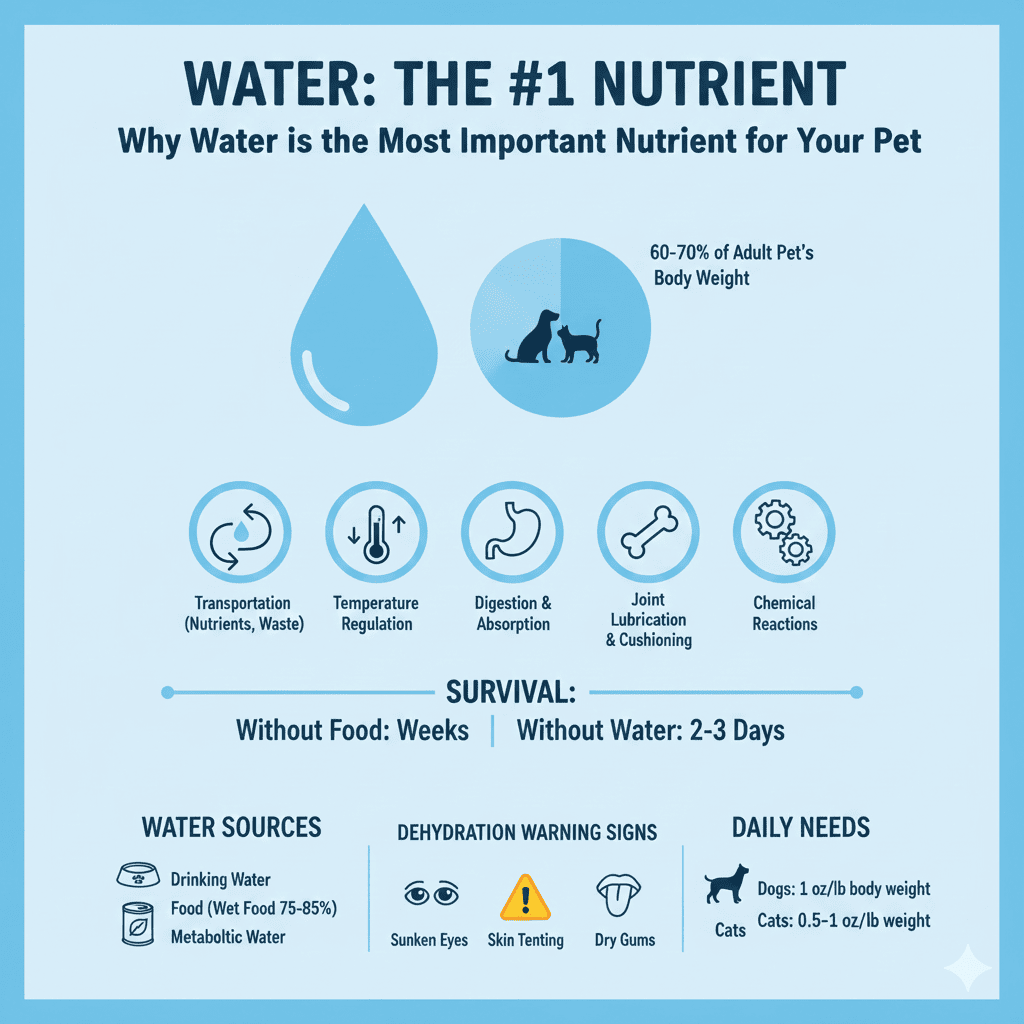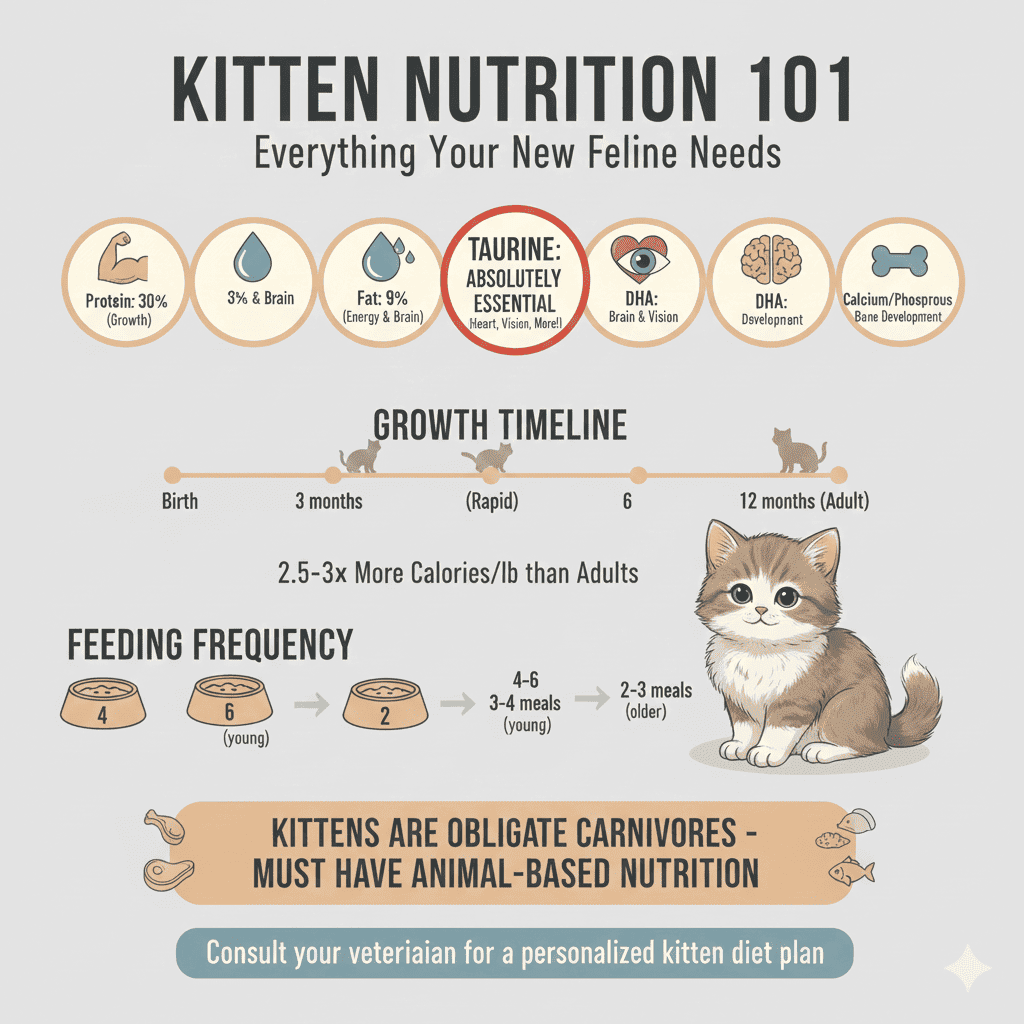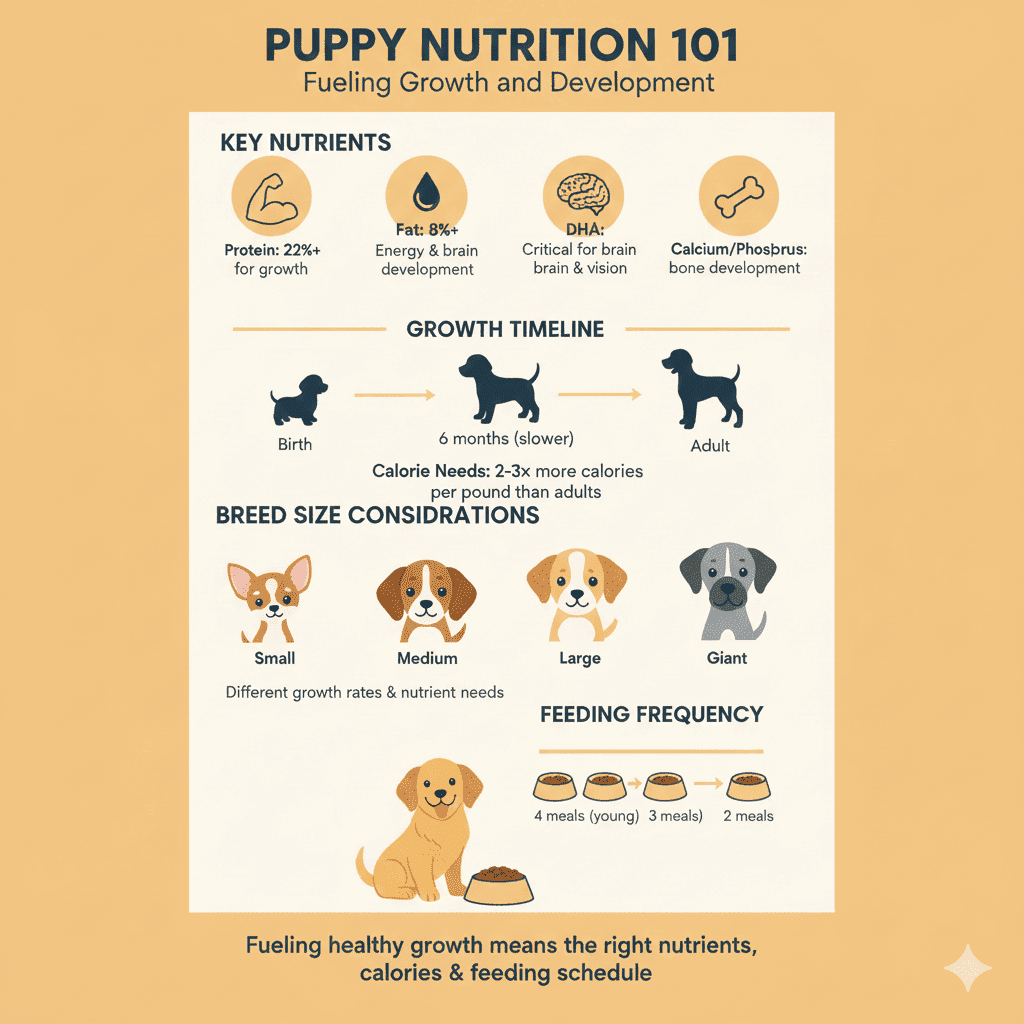You spend time researching the best protein sources, comparing fat percentages, and analyzing ingredient lists. But there's one nutrient that's more important than all of these combined—and it's probably the one you think about least.
Water.
Not protein. Not fat. Not vitamins or minerals. Water is the single most important nutrient for your pet. Without it, your pet would die in days. Without adequate hydration, every other nutrient becomes useless, and your pet's body cannot function.
Understanding water's critical role in your pet's health is fundamental to being a responsible pet owner. It's not just about filling a water bowl—it's about ensuring your pet has the foundation of life itself.
Why Water is Number One
The Survival Timeline
Without food:
- Pets can survive weeks to months (depending on body condition)
- Body uses stored fat and muscle for energy
- Gradual decline, but survival is possible
Without water:
- Pets can survive only 2-3 days
- Body systems begin shutting down immediately
- Death is rapid and certain
This stark difference shows why water is the most critical nutrient. Everything else can wait; water cannot.
The Percentage of Life
Water makes up a massive portion of your pet's body:
- 60-70% of an adult pet's body weight is water
- 80% of a puppy or kitten's body weight is water
- Every cell, every tissue, every organ depends on water

What Water Does in Your Pet's Body
1. Transportation System
Water is the body's delivery system:
- Carries nutrients to cells throughout the body
- Removes waste products from cells
- Transports oxygen in the blood
- Delivers hormones and other chemical messengers
Without adequate water, nutrients can't reach cells, and waste products build up, leading to toxicity and organ failure.
2. Temperature Regulation
Pets don't sweat like humans. Instead, they:
- Pant (dogs) to evaporate water and cool down
- Lick their fur (cats) to use evaporative cooling
- Seek shade and water when overheated
Without enough water, pets cannot regulate their body temperature, leading to heatstroke and potentially fatal overheating.
3. Digestion and Nutrient Absorption
Water is essential for:
- Breaking down food in the digestive system
- Absorbing nutrients from the intestines
- Moving food through the digestive tract
- Preventing constipation
Dehydration leads to poor digestion, nutrient malabsorption, and digestive problems.
4. Joint and Organ Protection
Water provides:
- Lubrication for joints (synovial fluid is mostly water)
- Cushioning for organs (organs are bathed in fluid)
- Protection for the brain and spinal cord (cerebrospinal fluid)
Without adequate hydration, joints become stiff, organs can be damaged, and the nervous system is at risk.
5. Chemical Reactions
Every biochemical reaction in your pet's body requires water:
- Metabolism: Breaking down food for energy
- Protein synthesis: Building new tissues
- Enzyme function: All enzymes work in water-based environments
- Cellular processes: Every cell function depends on water
How Much Water Do Pets Need?
General Guidelines
Dogs:
- Minimum: 1 ounce of water per pound of body weight per day
- Example: 50-pound dog needs at least 50 ounces (about 6 cups) per day
- Active dogs: May need 2-3 times more
- Hot weather: Significantly increased needs
Cats:
- Minimum: 1/2 to 1 ounce of water per pound of body weight per day
- Example: 10-pound cat needs 5-10 ounces per day
- Cats on dry food: Need more water than cats on wet food
- Cats are prone to low water intake: This is a common problem
Factors That Increase Water Needs
Activity level:
- Active pets need more water
- Working dogs need significantly more
- Play and exercise increase requirements
Environmental conditions:
- Hot weather: Dramatically increases needs
- Humidity: Affects cooling ability
- Altitude: Higher altitudes increase needs
Health status:
- Illness: Fever, vomiting, diarrhea increase needs
- Kidney disease: May need more (or less, depending on condition)
- Diabetes: Increased urination requires more water
- Lactation: Nursing mothers need much more
Diet:
- Dry food: Requires more water intake
- Wet food: Provides significant water (75-85% moisture)
- High-sodium foods: Increase thirst
Life stage:
- Puppies and kittens: Higher percentage of body water, more active
- Seniors: May have reduced thirst drive or health issues
Sources of Water for Pets
Drinking Water
The primary source:
- Fresh, clean water should always be available
- Changed daily (or more often if needed)
- Multiple bowls for multi-pet households
- Accessible locations throughout the home
Food Water
Wet food:
- Contains 75-85% moisture
- Provides significant hydration
- Excellent for cats (who have low thirst drive)
- Can meet 50% or more of daily water needs
Dry food:
- Contains only 8-12% moisture
- Provides minimal hydration
- Pets must drink more water
- May not be sufficient for some pets (especially cats)
Raw/fresh foods:
- Contain 60-70% moisture
- Provide moderate hydration
- Better than dry food, less than wet food
Metabolic Water
Small contribution:
- Water produced during metabolism
- Breaking down nutrients creates some water
- Only a small portion of total needs
- Not a significant source
Signs of Dehydration
Early Signs
- Decreased skin elasticity: Gently pinch skin on back of neck—should spring back immediately
- Dry gums: Should be moist and slick
- Sunken eyes: May appear recessed
- Lethargy: Less energy, less interest in activities
- Decreased appetite: May eat less or stop eating
Advanced Signs
- Panting excessively: Trying to cool down
- Rapid heart rate: Body working harder
- Weakness: Difficulty standing or walking
- Collapse: Severe dehydration
- Shock: Life-threatening condition
The Skin Turgor Test
How to check:
- Gently pinch the skin on the back of your pet's neck
- Release and watch how quickly it returns to normal
- Normal: Returns immediately
- Mild dehydration: Returns in 1-2 seconds
- Moderate dehydration: Returns in 2-5 seconds
- Severe dehydration: Takes longer than 5 seconds or doesn't return
Note: This test is less reliable in older pets or those with loose skin.
Preventing Dehydration
For Dogs
Provide multiple water sources:
- Water bowls in multiple locations
- Outdoor water for yard access
- Travel water for outings
- Consider a pet water fountain (some dogs prefer moving water)
Encourage drinking:
- Add water to dry food
- Use ice cubes as treats (some dogs love them)
- Offer water during and after exercise
- Monitor intake, especially in hot weather
Watch for problems:
- Dogs that don't drink enough
- Excessive drinking (may indicate health issues)
- Changes in drinking patterns
For Cats
Cats are particularly prone to low water intake:
- Evolutionary trait: Descended from desert animals with low thirst drive
- Prefer running water: Many cats prefer fountains to still bowls
- Wet food helps: Provides significant hydration
- Multiple locations: Place water bowls away from food (cats prefer this)
Strategies to increase intake:
- Pet water fountains: Many cats prefer moving water
- Wet food: Provides significant water content
- Multiple water bowls: In different locations
- Flavor the water: Some cats prefer water with a bit of tuna juice (use sparingly)
- Ice cubes: Some cats enjoy playing with and licking ice
Red flags:
- Cat not drinking at all
- Only eating dry food (may not drink enough)
- Signs of dehydration
- Urinary problems (often related to low water intake)
Special Considerations
Hot Weather
Dramatically increased needs:
- Provide unlimited fresh water
- Add extra water bowls
- Bring water on walks and outings
- Avoid exercise during hottest parts of day
- Watch for signs of heatstroke
Travel
Always bring water:
- Portable water bowls
- Bottled water (if tap water quality is uncertain)
- Offer water frequently
- Don't rely on finding water sources
Illness
Increased needs:
- Fever increases water loss
- Vomiting and diarrhea cause significant water loss
- Some illnesses reduce thirst drive
- May need to encourage or assist drinking
- Consult veterinarian if concerned
Senior Pets
Potential issues:
- Reduced thirst drive
- Mobility issues (may not reach water)
- Health conditions affecting hydration
- Medications that increase water needs
- More prone to dehydration
Solutions:
- Multiple, easily accessible water sources
- Consider wet food for increased hydration
- Monitor water intake closely
- Regular veterinary checkups
The Link Between Water and Health
Urinary Health
Especially important for cats:
- Low water intake is a major risk factor for:
- Urinary tract infections
- Bladder stones
- Feline lower urinary tract disease (FLUTD)
- Kidney problems
Adequate hydration:
- Dilutes urine
- Flushes the urinary tract
- Prevents crystal and stone formation
- Supports kidney function
Kidney Health
Water is essential for:
- Filtering waste products
- Maintaining electrolyte balance
- Supporting kidney function
- Preventing kidney disease progression
Digestive Health
Water supports:
- Proper digestion
- Nutrient absorption
- Preventing constipation
- Maintaining healthy gut function
The Bottom Line
Water is not just important—it's essential. It's the foundation of life, the most critical nutrient, and the one thing your pet cannot survive without for more than a few days.
Key takeaways:
- ✅ Water is the single most important nutrient
- ✅ Pets need constant access to fresh, clean water
- ✅ Wet food provides significant hydration (especially important for cats)
- ✅ Monitor for signs of dehydration
- ✅ Increase water availability in hot weather, during illness, and for active pets
- ✅ Cats are particularly prone to low water intake—take extra care
Providing adequate hydration is one of the simplest yet most important things you can do for your pet's health. Fill those water bowls, consider wet food, and watch for signs of dehydration. Your pet's life literally depends on it.
Ready to ensure your pet stays properly hydrated? Use our pet meal planner to find foods that support hydration, and remember: water is always the top priority.
For more information on encouraging your cat to drink more water, see our article: 5 Creative Ways to Get Your Cat to Drink More Water.


